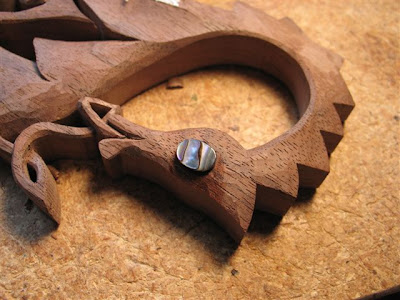
After last week's little tirade on the sad state of the craft market, I came back to my dragon raring to go. With all the major carving completed on the front of the spoon, this week is all about sweeping up any obvious inconsistancies, errors or annoyances which still remain.
Most of these lurk in the cutouts of the Celtic knotwork and the vines.
To deal with fuzzing of the wood, scruffy saw cuts or knicks and blemishes, I make use of needle files. These remarkable little files allow me to polish up rough areas without involving sandpapers. I find that the file (whether full sized or in needle form) saves me a ton of money on abrasive papers and even more time not having to fold up the sandpaper into odd shapes. They also have the great bonus of not leaving sanding grit behind in the wood and dulling my tools should I need to revist the area witht the knives. I don't spend a great deal of time with the filing as I will be turning the spoon over soon and working from the other side, so there will be a final opportunity for tune-ups later.
It IS however, a bit of a morale boost to have the front almost finished and to not have jobs hanging over my head before I go to work on the back.

Inevitably there are little areas which could benefit from a touch more knife work. Every time I turn around it seems like there is some aspect of this star which could be improved. I'll try to get as much as I can done now, but I anticipate spotting more on my last sweep when the whole spoon is complete. For now I go over the spoon with a nice little customized Flex cut pelican mini knife. For those of you with an interest in tools, to customize a pelican knife just like mine, simply drop it on a concrete floor while talking to some door-to-door type soliciting a sale. When the tip of the blade breaks off, you are ready to spend time at the grinder carefully trying to reshape things without over- heating the blade and loosing its temper. I should add that keeping the knife's temper is crucial...YOURS however, will be long gone!
 The vines could do with a little bit of touching up too. For this I rip a couple of narrow strips of cloth backed abrasive and I then run the strips over the vine as shown in the picture. Running the paper back and forth gives the edges a nice, soft 'roundover' which gives the vines a natural look. I don't ever use anything coarser than about 150 for this process (preferably 180 or 220) so that the scratch marks from the paper going across the grain don't make a mess of things. I'm more concerned with getting the edges neatly rounded than I am about removing material.
The vines could do with a little bit of touching up too. For this I rip a couple of narrow strips of cloth backed abrasive and I then run the strips over the vine as shown in the picture. Running the paper back and forth gives the edges a nice, soft 'roundover' which gives the vines a natural look. I don't ever use anything coarser than about 150 for this process (preferably 180 or 220) so that the scratch marks from the paper going across the grain don't make a mess of things. I'm more concerned with getting the edges neatly rounded than I am about removing material.

Lastly, I give the spoon bowl another light sanding with 220 grit paper. This cleans up any last scratches and also gets rid of any accumulated dirt which has adhered to the spoon during the carving process. I know that sounds as though perhaps I am carving in a farmyard, but you would be surprised at how pencil lines, eraser sweepings, grease from the hands and metal from the tools can conspire to take the sparkle from your work. A light buff at a super fine grit like this will get rid of that stuff and get the wood looking pristine again.
Next week I'm going to flip the spoon over and have some dusty, noisy, dangerous fun with an angle grinder. Who says its all comtemplative quiet in the carving studio?
In the meantime, please consider donating to the Left Coast Eisteddfod! With every week that passes, this exciting event draws nearer and your support becomes more and more vital. I hope you will consider becoming involved in the Eisteddfod as a donor, sponsor, volunteer or ticket holder! And if you know any AIG execs who got the big payouts last week, ask them to send a couple of crumbs our way!













